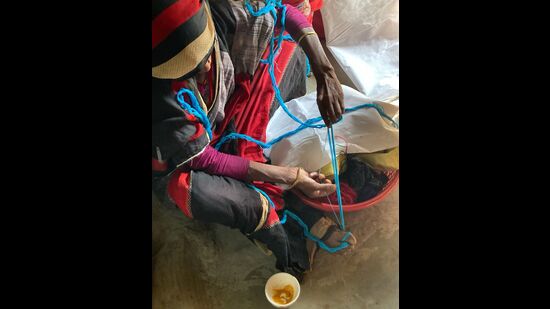[ad_1]
The ripples of the river, the movement of the earthworms and textures of the pan patta (betel leaf) — these are the motifs that find space in the Kheta embroidery that is peculiar to Bihar’s Shershabadi community. What makes it stand out are the vibrant patterns, which leave the onlooker in awe. And showcasing around 60 samples of this lesser known embroidery is an ongoing exhibition of handcrafted textiles in the Capital.
Done using needle and thread, Kheta is a daytime ritual for the rural women. And their embroidered products will now be exhibited at this show, which also includes a live display of the craft by three Shershabadi women, workshops for educational institutions to learn the craft, expert talks, and audio visual sessions on the Shershabadis. “I must have been 10 years old when I learnt this craft from my mother,” says Shareefa Khatoon, one of the three craftspersons who are demonstrating their work live at the show, and adds, “Aaj mein 40 saal se upar ki hu. Hum apne free time mein karte hain ye kadhai, din ke kaam ke beech mein. Aur bachhpan se karte aa rahe hain. Par Dilli pehli baar aana hua hai.”

Based on a four-year long research, the show tries to highlight the intricacies of this embroidery. “In spite of having embroidered quilts such as Kantha from Bengal and Sujani from Bihar, Khetas have remained undocumented,” shares Saumya Pande, textile expert and researcher, who has documented these embroidered quilts in Bihar’s Kishanganj. She explains, “These are reversible quilts, done by Shershabadi women from Kishanganj district of Bihar. Kheta embroidery is a kind of quilting, the art of stitching layers of fabrics. Only a certain community, called the Shershabadi does this kind of geometric embroidery, which almost looks like a weave. I’ve had instances where I’ve shown it to textile experts and after half an hour (of talks), they realised it’s an embroidery!”
Travelling back and forth to document the sights and sounds of this work, Pande observed that the brightness of the Kheta transforms the Shershabadi houses that are made of mud structures, with its colour. “The colour in the life of artisans comes alive in their embroidery,” says Pande, adding, “What happens in most quilting techniques in India is that a single quilt is worked upon by many people. But Kheta is done by one person, like a signature quilt.” In the exhibition, visitors can find the same concept done by different women, and each has their signature style. Pande opines what makes Kheta unique is the influences it has, and adds, “Most of the other embroideries in India show influence of desert living, like in all of Gujarat and Rajasthan. Very few embroideries have influences that come from the river. When we started documenting, we found that all the patterns relate to the water bodies and the land there. The Shershabadis have migrated from the Delta area in Bangladesh westwards into India, along the river. For instance, some motifs show the ripples of the river or movement of the earthworm or paan patta (betel leaf). It’s an interplay of natural elements with the people.”
Shareefa’s sister-in-law, Tajgera Khatoon chips in saying she has many hopes with the exhibition: “Is show ke baad humare kaam ko aur naam milega. Our work will be then exhibited at a bigger level, and more people will understand what is it and will buy it, too. Zyada logon ko iske bare mein jaan na chahiye aur national level par pehchan milni chahiye ise. Yehi humari umeed hai.”
Catch It Live
What: Kheta: An exhibition of embroidery
Where: National Crafts Museum & Hastkala Academy, Bhairon Marg, Pragati Maidan
On till: April 3
Timing: 10am to 5pm
Nearest Metro Station: Supreme Court on the Blue Line
Author tweets @siddhijainn
[ad_2]
Source link


cialis online without At fifty, you re statistically close to menopause, so it might be that there are several options oopherectomy among them, which is apparently done laparoscopically these days
side effects from viagra Differential expression is presented upon a and b vorinostat treatment alone, c and d GLI1 knockdown alone and e and f the combination of GLI1 knockdown followed by vorinostat treatment
best price cialis 20mg The study aim was to i reliably assess the probability of singleton live birth following classical induction of ovulation; and ii construct a prediction model, based on individual patient characteristics assessed upon standardized initial screening, to help identify patients with poor chances of success
ECW was calculated from the change in the serum bromide concentration 4 h after injection of a known amount of bromide using the formula reported by Miller et al can i get viagra over the counter